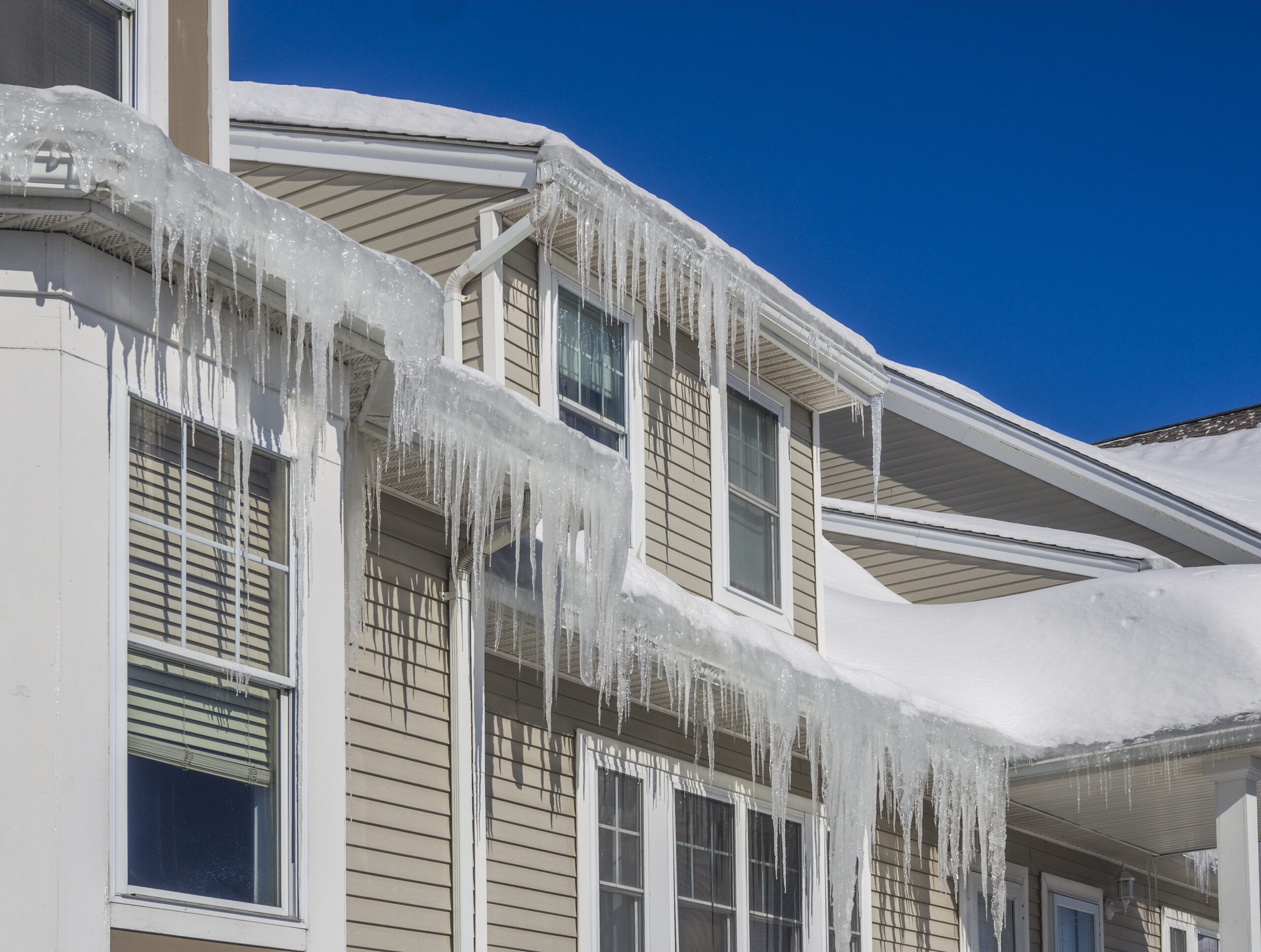Roof Report
Ice Dams: What They Are and How to Get Rid of Them

Most of us can agree there is something magical about a string of icicles dangling from the gutters on a cold winter day. However, those same decorative pieces straight from Mother Nature’s art collection can cause some serious damage to your roof, attic, and home. From tearing off your gutters to loosening roofing shingles to backing up water into your home, the destructive path of ice dams demands swift action and long-term prevention. And King Quality is here with a gameplan for the winter.
What are ice dams?
Snow-covered roofs and freezing weather are the two culprits behind both beautiful icicles and the thick ridges of solid ice that build up along the eaves—also known as ice dams. Despite forming from the same root cause, icicles and ice dams hardly compare in their impact to your roof and home. We know that icicles form when snow melts and freezes. But there is more to ice dams than meets the eye.
The lifecycle of an ice dam.
Ice dams form in three stages: birth, growth, and maturity. Birth happens when heat collects in the attic and warms the roof, except at the eaves. Growth happens when snow melts on top of the roof and freezes on the cold eaves. And maturity happens when ice accumulates along the eaves and forms an ice dam, causing meltwater from the warm roof to back up behind it, flow under the shingles, and leak into the house.
Why are ice dams bad?
After lifting shingles and causing leaks, ice dams can peel paint, warp floors, stain and sag ceilings, and create soggy attic insulation that can lose its R-value and become a magnet for mold and mildew. There is no limit to the damage ice dams can cause. However, there are things you can do to stay ahead of the game this winter.
Take pictures and inspect for leaks.
First, take pictures of any frosty buildup you spot on the outside of your home and use them to target an interior inspection. Check for leaks inside the attic, which are the calling card of ice dams.
Install heated cables.
Heated cables equalize your roof’s temperature by heating it from the outside. Attach heated cables along the roof’s edge in a zigzag pattern to help prevent ice dams. However, this proactive measure only works before the bad weather hits unlike the other quick fixes you can implement in the aftermath.
Quick fixes to handle ice dams right now.
You might think it makes sense to hack away at ice dams with a hammer, chisel, or shovel. However, this method is bad for your roofing—and dangerous for you. Throwing salt at the problem sounds like another solution but will do more to harm to your plantings than the ice.
What you can do is pull off snow with a long-handled aluminum roof rake (while standing safely on the ground), which can instantly change the exterior temperature of your roof without damaging the shingles.
For another quick fix, position a box fan inside the attic, aim it at the underside of the roof, and blow cold air to stop meltwater from leaking inside. This targeted dose of cold air will freeze water in its tracks, stopping the leak in a matter of minutes.
De-icing is another smart strategy. For example, you can fill pantyhose with calcium chloride ice melter and lay it onto the roof so it crosses the ice dam and overhangs the gutter. (You can grab your long-handled garden rake to push the pantyhose into position.) The calcium chloride will eventually melt through the snow and ice, creating a channel for water to flow down into the gutters or off the roof. This solution can significantly diminish the damage caused by an ice dam.
Long-term fixes to get rid of ice dams for good.
Getting rid of ice dams for good is simple in theory: just keep the roof the same temperature as the eaves. And you can do that by increasing ventilation, adding insulation, and sealing off every possible air leak that might warm the underside of the roof. HVAC duct and piping on the inside of the roof, for example, can help maintain even temperature throughout.
Common trouble spots that lead to ice dams.
There are notorious areas of the home known to cause ice dams including the eaves, ridge, hatches, exhaust, insulation, and ducts. And there are steps you can take to stop these spots from causing trouble.
At the eaves and ridge.
Focus on ventilation at this common trouble spot. A ridge vent and continuous soffit vents work together to circulate cold air under the roof. Ridge and soffit vents with the same size openings work best. Make sure to include at least one square foot of opening for every 300 square feet of attic floor. And place baffles at the eaves to maintain a clear path for the airflow from the soffit vents.
At the hatch.
Unsealed attic hatches and whole-house fans create massive openings for heat to escape. Cover hatches in your home with weatherstripped caps made from foil-faced foam board held together with aluminum tape.
Exhaust to the outside.
Make sure the ducts connected to the kitchen, bathroom, and dryer vents all lead outdoors through either the roof or walls, but never through the soffit.
Add insulation.
More insulation on the attic floor keeps the heat where it belongs. Find out how much insulation your attic needs and make sure to meet the requirements.
Install sealed can lights.
Old-style recessed lights give off great plumes of heat. However, insulating them creates a fire hazard. Instead, swap them out for sealed “IC” fixtures, which are more insulation friendly.
Flashing around chimneys.
Bridge the gap between the chimney and house framing with L-shaped steel flashing. Use unbroken beads of a fire-stop sealant to hold the flashing in place, which is more fire-safe than canned spray foam or insulation.
Seal and insulate ducts.
Spread fiber-reinforced mastic on the joints of HVAC ducts and exhaust ducts, covering them entirely with R-5 or R-6 foil-faced fiberglass.
Caulk penetrations.
Seal around electrical cables and vent pipes with a fire-stop sealant. Inspect for spots where the light shines up from below or where the insulation is stained black by the dirt from passing air.
Royal treatment for you and your home.
If tackling ice dams on your own sounds like more trouble than you care to handle, hire a professional to get your attic, roof, and home in shape for the winter.
At King Quality, we put decades of experience behind every project to give you peace of mind. Contact us before or after ice dams hit and discover royal treatment for you and your home.









